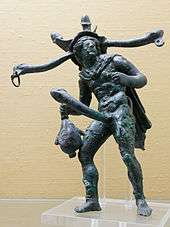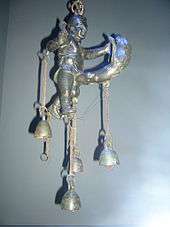Tintinnabulum (Ancient Rome)


In ancient Rome, a tintinnabulum (less often tintinnum)[1] was a wind chime or assemblage of bells. A tintinnabulum often took the form of a bronze phallic figure or fascinum, a magico-religious phallus thought to ward off the evil eye and bring good fortune and prosperity.
A tintinnabulum was hung outdoors in locations such as gardens, porticoes, houses, and shops, where the wind would cause them to tinkle. The sounds of bells were believed to keep away evil spirits; compare the apotropaic role of the bell in the "bell, book, and candle" ritual of the earlier Catholic Church.[2]
Hand-bells have been found in sanctuaries and other settings that indicate their religious usage, and were used at the Temple of Iuppiter Tonans, "Jupiter the Thunderer."[3] Elaborately decorated pendants for tintinnabula occur in Etruscan settings, depicting for example women carding wool, spinning, and weaving.[4] Bells were hung on the necks of domestic animals such as horses and sheep to keep track of the animals, but perhaps also for apotropaic purposes.[5]
See also
- Erotic art in Pompeii and Herculaneum
- Lucky Charms (disambiguation)
- Mutunus Tutunus
- Priapus
- Sexuality in ancient Rome
References
- ↑ In the Latin of 6th-century Roman Gaul; J.N. Adams, The Regional Diversification of Latin, 200 BC–AD 600 (Cambridge University Press, 2007), p. 321.
- ↑ "Bronze phallic wind chime (tintinabulum)". Highlights from the British Museum.
- ↑ Duncan Fishwick, Imperial Cult in the Latin West (Brill, 1990), vol. II.1, pp. 504-5.
- ↑ Larissa Bonfante, Etruscan Life and Afterlife: A Handbook of Etruscan Studies (Wayne State University Press, 1986), p. 252.
- ↑ Adams, Regional Diversification, p. 321.
Further reading
- Sex or symbol: erotic images of Greece and Rome by Catherine Johns, The British Museum Press (1982) ISBN 0-7141-8042-4
- Eros in Pompeii: the erotic art collection of the Museum of Naples by Michael Grant, Antonia Mulas, Museo nazionale di Napoli (1997)
- Experiencing Rome: culture, identity and power in the Roman Empire by Janet Huskinson, Routledge, (2000) p. 171
- Herculaneum, Italy's buried treasure by Joseph Jay Deiss (1989) p. 38
- The Roman cultural revolution by Thomas N. Habinek, Alessandro Schiesaro (1997) p. 171
External links
| Wikimedia Commons has media related to Ancient Roman Tintinnabulum. |
- Highlights from the British Museum: Lion-phallus, winged phallus, diphallic figure
- Metropolitan Museum of Art: Bronze phallic ornament